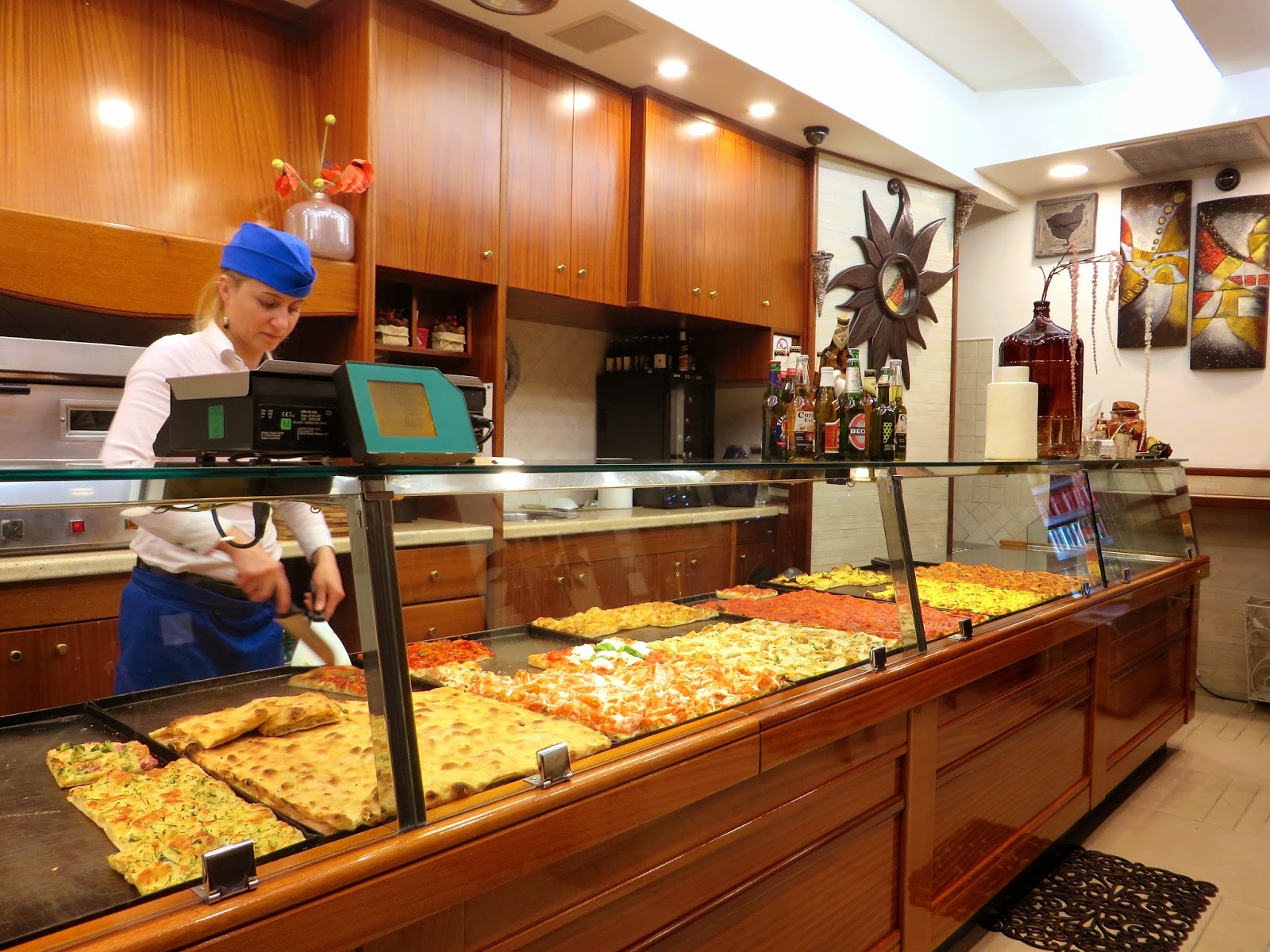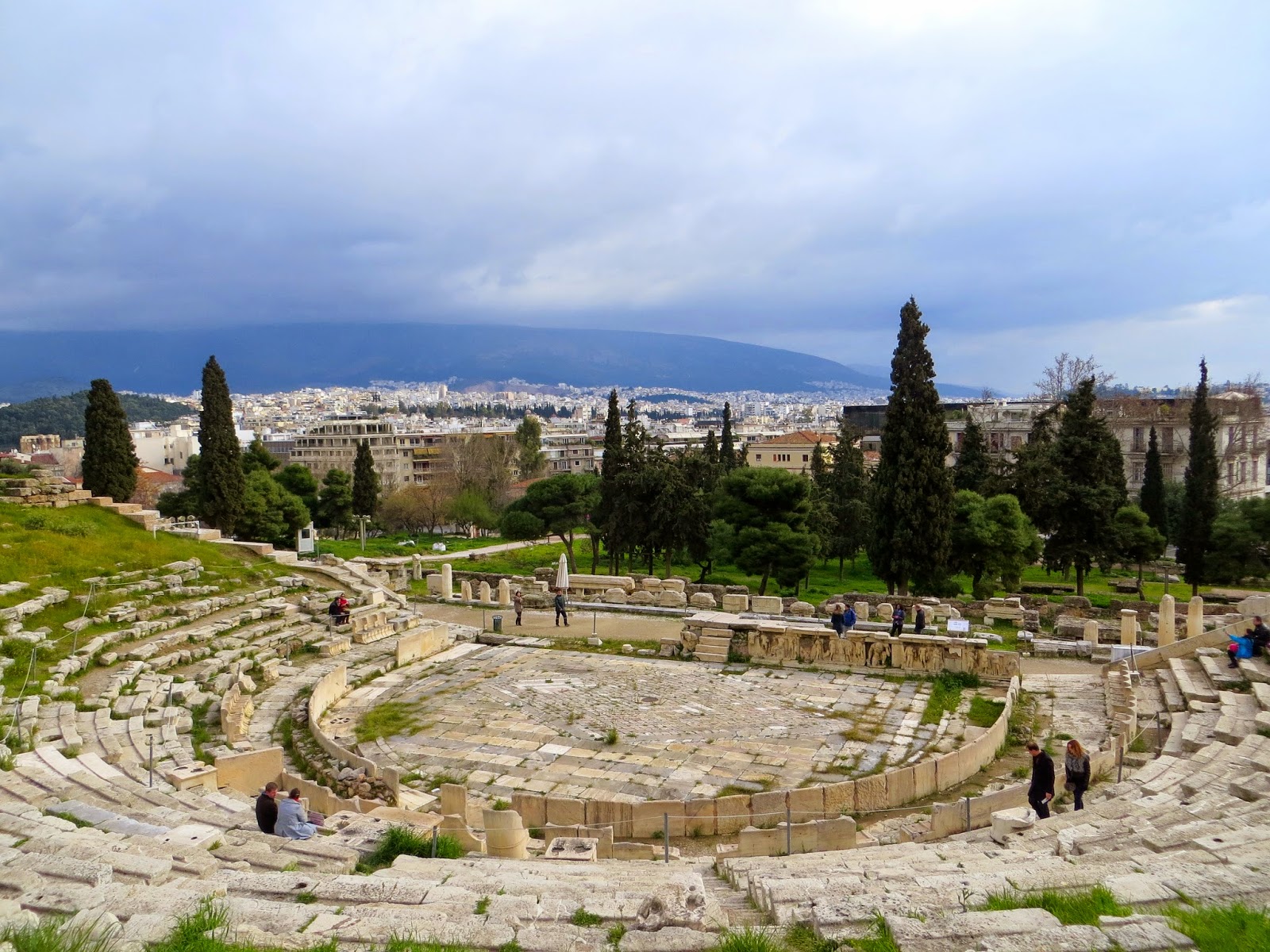As you can tell from the title, this post is going to be all about the wonderful and delicious food of Italy, and it will be long, because I spent a lot of time researching and trying out the best cheap eats in this culinary capital. Since I consider myself a budget traveller, I always scout out the best places at the lowest prices. Rome has a lot of great, inexpensive eats! Though we didn't engage in any traditional Italian fine dining, with multiple courses and exquisite wine, I would say we definitely were able to eat our way through Rome!
I'll start with pizza, which are the ultimate affordable and filling quick bite in Italy. Pizza is to Italy what Souvlaki is to Greece, in my opinion.
Most neighborhoods will have small nondescript pizza shops, which still offer pizza that is quite superior to your average American pizza. The pizza is all laid out in a counter, in rectangular shapes, and you buy the pizza by the gram. There are a lot of different types of pizza, some without cheese, and with lots of vegetable options like potatoes, onions, and broccoli.
When we were in a hurry we would usually go to the nearest small pizza place, but of course I also wanted to try the best that Rome has to offer. I found that generally the difference between the top pizza shops and the average shops is that the ingredients are more fresh and higher quality, the crust is crispy and light, and the people are friendly and more adept at helping tourists.
We went to several shops that were rated highly on Tripadvisor. One of the first that we tried is called Zizi's Pizza. It is a decent family-owned joint, with a great variety of pizzas. We tried one with fresh mozzarella and prosciutto, and one with broccoli and spinach. I noticed that in Italy, cheese is merely one type of topping on pizza, unlike in the United States, where pizza is nearly always smothered in melted cheese.
The best pizza, hands down, is at Pinsere, a few blocks from the main train station. When I was there, it was rated #2 on Tripadvisor out of about 9,000 restaurants in Rome, which is incredible! If you are in Rome, you've gotta gotta gotta go here! It fully lives up to it's hype.
The place is tiny, and there is only a bit of counter space inside and outside where you can stand and eat. Don't let that deter you - the pizza here is out of this world delicious. The pizza comes in all sorts of creative varieties, in personal pan sizes. The pizza on the counter is partially cooked, and then after you order it is heated in a big oven. On the side, through glass, you can see the workers busily working with fresh dough.
Below is the two pizzas we chose to split - a potato and onion one, and a ham and cheese one. After it's done baking to perfection, it is drizzled lightly with truffle oil. Yum! After all this talk, you probably won't believe that I'm actually not a huge pizza fan in my normal life, but I will never forget the pizza from Pinsere. Trust me, it's worth a slight detour from your itinerary.
You can use the money you save on breakfast to buy coffee...and gelato of course! I had gelato almost every afternoon. When in Rome... right? I couldn't help it - there are so many quality, artisanal gelato shops with delectable flavors (Nutella, yogurt, pistachio, rum and raisin....the list goes on).
One famous institution is called Giolliti, and it has been open since 1890. I read somewhere that it is Italy's oldest ice cream shop. It was insanely crowded, packed with tourist groups and school kids, but we managed to fight through to get our gelato! There are dozens of flavors projected on screens above on the walls.
Gelato is deliciously rich and creamy. I found that the chocolate flavors were usually solid, whereas some of the others were too sweet. The sign of good gelato is when the colors are muted and rich, rather than bright and artificial. It shows that the shop does not add additional colorings to the mix.
Pistachio tiramisu is also delicious! This one below is from a great little shop in Venice called I Tre Mercanti. They make their tiramisu everyday in the shop, and also sell other specialty local products, like pastas, chocolates, and oils.
As you can, I definitely had my share of terrific eats in Italy (and this is not even mentioning the pastas and panini). These daily indulgences were balanced out by miles and miles of walking. I'm not sure I can ever fully enjoy pizza and ice cream here in the states again.
I'll start with pizza, which are the ultimate affordable and filling quick bite in Italy. Pizza is to Italy what Souvlaki is to Greece, in my opinion.
Most neighborhoods will have small nondescript pizza shops, which still offer pizza that is quite superior to your average American pizza. The pizza is all laid out in a counter, in rectangular shapes, and you buy the pizza by the gram. There are a lot of different types of pizza, some without cheese, and with lots of vegetable options like potatoes, onions, and broccoli.
After you tell the person working behind the counter how much you want, they heat the slice up for you so that your pizza is warm and toasty. You can get a decently healthy meal (like this pizza below with tomatoes and bell peppers) for about $5 USD.
When we were in a hurry we would usually go to the nearest small pizza place, but of course I also wanted to try the best that Rome has to offer. I found that generally the difference between the top pizza shops and the average shops is that the ingredients are more fresh and higher quality, the crust is crispy and light, and the people are friendly and more adept at helping tourists.
We went to several shops that were rated highly on Tripadvisor. One of the first that we tried is called Zizi's Pizza. It is a decent family-owned joint, with a great variety of pizzas. We tried one with fresh mozzarella and prosciutto, and one with broccoli and spinach. I noticed that in Italy, cheese is merely one type of topping on pizza, unlike in the United States, where pizza is nearly always smothered in melted cheese.
The best pizza, hands down, is at Pinsere, a few blocks from the main train station. When I was there, it was rated #2 on Tripadvisor out of about 9,000 restaurants in Rome, which is incredible! If you are in Rome, you've gotta gotta gotta go here! It fully lives up to it's hype.
The place is tiny, and there is only a bit of counter space inside and outside where you can stand and eat. Don't let that deter you - the pizza here is out of this world delicious. The pizza comes in all sorts of creative varieties, in personal pan sizes. The pizza on the counter is partially cooked, and then after you order it is heated in a big oven. On the side, through glass, you can see the workers busily working with fresh dough.
There are all sorts of options, with fresh sliced meats and cheese, vegetables, and even one with nuts and pears. I believe there is a vegan option as well. Each pizza easily feeds one person and is $5-6.
Below is the two pizzas we chose to split - a potato and onion one, and a ham and cheese one. After it's done baking to perfection, it is drizzled lightly with truffle oil. Yum! After all this talk, you probably won't believe that I'm actually not a huge pizza fan in my normal life, but I will never forget the pizza from Pinsere. Trust me, it's worth a slight detour from your itinerary.
Another way to save money is to cook a few meals yourself if you have kitchen access. I bought and cooked most breakfasts. Usually, I would make some time to run to a local fruit mart or grocery and buy some eggs, cheese, and tomatoes. It's affordable, quick, and healthy!
You can use the money you save on breakfast to buy coffee...and gelato of course! I had gelato almost every afternoon. When in Rome... right? I couldn't help it - there are so many quality, artisanal gelato shops with delectable flavors (Nutella, yogurt, pistachio, rum and raisin....the list goes on).
One famous institution is called Giolliti, and it has been open since 1890. I read somewhere that it is Italy's oldest ice cream shop. It was insanely crowded, packed with tourist groups and school kids, but we managed to fight through to get our gelato! There are dozens of flavors projected on screens above on the walls.
Gelato is deliciously rich and creamy. I found that the chocolate flavors were usually solid, whereas some of the others were too sweet. The sign of good gelato is when the colors are muted and rich, rather than bright and artificial. It shows that the shop does not add additional colorings to the mix.
Lastly, another dessert that I enjoyed immensely is tiramisu. It's light, creamy, with a dusty of coffee - what's not to like? It usually comes in several flavors like original, pistachio, and hazelnut.
A popular shop in Rome is called Pompi. It seems to mostly cater towards tourists, but I found it to be very light and tasty. You get a little box for about $4.
Pistachio tiramisu is also delicious! This one below is from a great little shop in Venice called I Tre Mercanti. They make their tiramisu everyday in the shop, and also sell other specialty local products, like pastas, chocolates, and oils.
As you can, I definitely had my share of terrific eats in Italy (and this is not even mentioning the pastas and panini). These daily indulgences were balanced out by miles and miles of walking. I'm not sure I can ever fully enjoy pizza and ice cream here in the states again.






















































